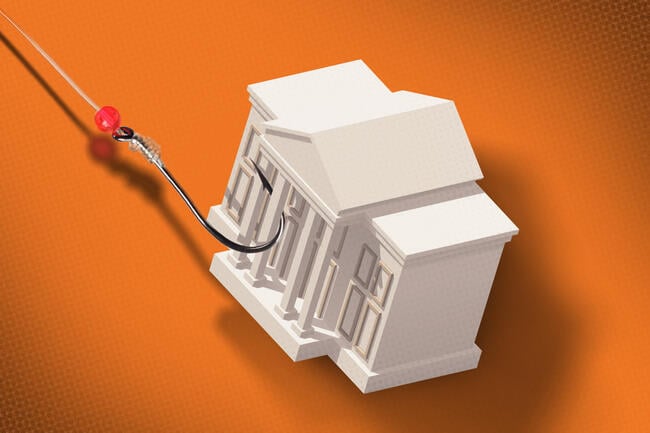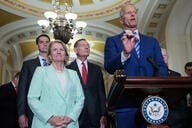You have /5 articles left.
Sign up for a free account or log in.

The Republican bill would require colleges to pay back part of a students’ unpaid loans.
Photo illustration by Justin Morrison/Inside Higher Ed | skodonnell/E+/Getty Images | tarras79/iStock/Getty Images
House Republicans are planning to upend how students and families pay for college in order to cut $330 billion in federal spending, according to draft legislation released Monday.
The House Education and the Workforce Committee held a markup on this reconciliation bill Tuesday. For reactions from both sides of the aisle, read Inside Higher Ed’s coverage here.
Lawmakers and supporters of the sweeping plan, which includes cutting off subsidized loans to undergraduates next year, capping loans for existing borrowers and ending the graduate student loan program, say the changes are necessary to address the student debt crisis and hold colleges accountable. But student advocates fear it will make college inaccessible.
The House Committee on Education and the Workforce will mark up the legislation Tuesday. Among other changes, the bill would put colleges partially on the hook for unpaid student loans, consolidate income-driven repayment plans, repeal Biden-era regulations and make changes to which students and programs are eligible for the Pell Grant.
Rep. Tim Walberg, a Michigan Republican and the chair of the House education committee, said in a statement Monday that the legislation addresses the root causes of “skyrocketing college costs” and holds colleges responsible for “loading students up with debt.”
“Colleges have ridden this gravy train of taxpayer dollars without any accountability,” Walberg said. “Bottom line, it’s time to fix this broken cycle that is costly to taxpayers and leaves students worse off than if they never went to college.”
Many of the provisions are pulled from the College Cost Reduction Act, a sweeping plan to reform higher education that House Republicans introduced last year but that didn’t move forward. Multiple student advocacy groups, including the Institute for College Access and Success, have consistently criticized those proposals.
“The committee’s current proposal would severely restrict college access,” TICAS president Sameer Gadkaree said in a recent statement. “No student seeking higher education should face barriers that limit their potential both prior to starting college and in the decades that follow graduation.”
First Step in a Broader Process
The 103-page bill, known as the Student Success and Taxpayer Savings Plan, is part of House Republicans’ plan for reconciliation, an atypical legislative process that lawmakers are planning to use to fund President Donald Trump’s priorities such as lofty tax cuts for wealthy people and an aggressive crackdown on immigration.
All provisions included in the complex bill will have to deal with the budget, but only a simple majority of lawmakers in the Senate and House have to support the legislation in order for it to pass, making the bill filibuster-proof.
The House is aiming to cut $1.5 trillion, according to a budget resolution adopted earlier this month. The Senate’s goal is $4 billion. That budget resolution directs the House education and workforce committee to cut $330 billion. Meanwhile, the Senate Health, Education, Labor and Pensions committee was only told to cut $1 billion.
Both chambers will eventually have to agree on specifics in order to turn what Trump calls the “big beautiful bill” into law. Tuesday’s markup is the first step in doing so, but as one lobbyist said, “There’s still a lot of political gamesmanship going on” and both chambers have a long way to go before they reach a compromise and pass identical bills.
The House Committee on Education and the Workforce is just one panel considering changes that would affect colleges and universities. For example, the Ways and Means Committee is considering raising the endowment tax, and the Committee on Energy and Commerce could make significant changes to Medicaid, which would likely affect public colleges’ finances.
Loans and Pell Grants
The bulk of the legislation’s proposals generally revolve around three categories—increasing accountability measures, consolidating income-driven repayment plans and reducing other loan options. The committee first signaled these as core focus areas through a menu of potential cuts leaked to the Punchbowl in January, raising alarms among higher education advocates.
But in some ways, Monday’s formal bill text goes well beyond the original menu.
For example, the draft bill would eliminate subsidized loans for future borrowers, starting July 1, 2026. Currently, this type of need-based loan doesn’t accrue interest while its borrower is in college; it also then gives that student a six-month grace period after graduation before their first payment is due. About 30.2 million borrowers currently have subsidized loans, totaling $294.4 billion, according to federal student loan data.
But now, all borrowers—regardless of income—will only be able to take out an unsubsidized loan, which lacks the same benefits. Pre-existing undergraduate borrowers would still have access to subsidized loans, but starting July 1, 2026, how much they can borrow will be based on the median cost of their program.
The legislation also would end the Grad PLUS program but would restrict eligibility for the Parent PLUS program.
Graduate student debt—which makes up nearly half of the $1.7 trillion student loan portfolio—has seen more scrutiny from lawmakers who argue that not all graduate programs pay off and that access to the Grad PLUS program has raised the cost of college. (Under Grad PLUS, students can borrow up to the cost of attendance. The draft bill would cap loans a student can take out at $100,000 for graduate students and $150,000 for professional students.)
Meanwhile, Parent PLUS allows guardians to take out loans to finance their dependents’ education. These loans aren’t currently capped and have higher interest rates than the standard direct loan. The program has been critical for historically Black colleges and universities and helped Black students access higher education, multiple reports have found. But some researchers say the Parent PLUS loans exacerbate the generational and racial wealth gaps.
The Student Borrower Protection Center warned in a blog post Monday that eliminating the Grad PLUS program without also lowering the cost of graduate programs would send students to the private loan market, which they argue is predatory and unregulated.
The bill also includes unexpected provisions concerning the $30 billion Pell Grant program.
It would open the grant to short-term programs while also cutting off access for students enrolled in fewer than six credit hours. Students in workforce programs are exempt from that cutoff. The legislation also allocates more funding to the program to cover an expected shortfall. Community colleges will likely be most affected by the eligibility changes, and their representatives in D.C. are “deeply concerned.”
“These students are almost always working a substantial number of hours each week and often have family responsibilities. Pell Grants help them meet the cost of tuition and required fees,” said David Baime, senior vice president for government relations for the American Association of Community Colleges. “We commend the committee for identifying substantial additional resources to help finance Pell, but it should not come at the cost of undermining the ability of low-income working students to enroll at a community college.”
Repayment and Accountability
Beyond changing the types of loans students take out, the proposed plan would also change how students repay their debt by consolidating four existing income-driven repayment plans into one.
In order to continue formulating monthly payments by income while also tightening the reins on loan forgiveness, the House suggests waiving borrowers’ interest if their monthly payment isn’t enough to cover what’s owed and the accrued interest. Borrowers would see their remaining balances forgiven after making qualifying payments for 30 years. Current IDR plans offer forgiveness after 20 or 25 years.
“The proposal aims to address the most vexing problem in the income-driven repayment system: negative amortization,” said Preston Cooper, a senior fellow at the conservative think tank the American Enterprise Institute. “The House proposal would ensure that borrowers who keep up with their payments will pay down their principal over time—and eventually pay off their balances in full, without the need for loan forgiveness.”
But the proposed measures to hold colleges accountable will likely be the most disruptive change for colleges. As experts predicted, the House plan would require colleges to pay the government a portion of students’ unpaid loans. Cooper said that this version of risk-sharing is “less aggressive” than what Republicans proposed last Congress.
But Jason Delisle, a nonresident senior fellow at the Urban Institute’s Center on Education Data and Policy, said that almost any accountability measure, no matter what it entails, would cause a “paradigm shift.”
Higher ed lobbyists opposed a similar plan when it was introduced last Congress and are expected to do so again. MacGregor Obergfell, director of government affairs at the Association of Public and Land-grant Universities, argued that under the current proposal, colleges that provide an opportunity for socioeconomic mobility to the lowest-income students will be hit the hardest.
“The institutions that received the lowest amount of state funding, and that enrolled high numbers of nontraditional and underrepresented students, are going to face the highest cuts,” he said. “It’s just holding institutions accountable in a way that doesn’t accurately capture the students they serve, the missions they have or how states fund institutions.”
Will the Senate Agree?
The Senate HELP Committee hasn’t yet released its plan. But legislation previously introduced by key lawmakers suggests the upper chamber has a different vision from the House on how to tackle higher ed reform.
For instance, while the House prefers risk-sharing, the Senate is expected to back a measure that judges programs by their students’ employment rates and income levels after graduation, based on legislation introduced by Sen. Bill Cassidy, a Louisiana Republican and chair of the education panel. Much like the Biden- and Obama-era gainful-employment regulations, failure to meet this threshold would mean an end to accessing federal financial aid.
Cassidy’s bills, first introduced in spring 2023, also handle student loans differently. As far as loan caps go, the Senate wants to ax PLUS loans and leave direct loans as they stand. It also supported reverting to an Obama-era IDR plan where interest remains and balances can grow, but the loans are automatically forgiven after a certain period of time.
Whatever side they take on each of the issues, experts largely agree that the House committee’s bill is just the starting point for talks with the Senate.
“No massive tax-and-spending budget reconciliation bill has been passed by Memorial Day. It’s usually around Christmas,” Delisle said. “The House and Senate are really far apart on possibly thousands of provisions across these bills. So there’s just a long way to go and a lot could happen.”
(The story was corrected to reflect that the proposed bill keeps the Parent PLUS program.)




